alto flute
All scores that include a part for at least one alto flute.
-
Mozart - Sonata in A Major, K.305 - Alto Flute
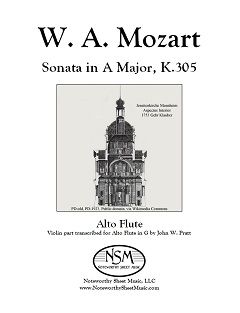 Sonata in A Major, K.305, by W. A. Mozart
Sonata in A Major, K.305, by W. A. MozartTranscribed for Alto Flute and Piano by John W. Pratt
Alto Flute Part, PDF $3.99
Mozart's Sonata in A Major, K.305 is perhaps the most completely extroverted of the Mannheim sonatas. Like K.302, it opens with four emphatically tonic bars, followed by a gentle, linear four-bar theme, all immediately repeated. The second movement of K.305 is the only movement of the Mannheim sonatas in theme-and-variations form. It is far from routine. The theme has an unusual variety of rhythms and accompaniment figurations; the 32nd-note variation is the very first, not a later one; the minor variation is at the prevailing tempo, not slow; and a brief but telling piano cadenza interrupts the antepenultimate variation's peroration. (excerpted from JWP's foreword to the edition)
We provide the transcribed alto flute part—the piano scoreis available in the public domain as a free pdf download from imslp.org/.
Alto Flute part, 4 pages; Total, 6 pages.
Preview -
Mozart - Sonata in C Major, K.296 - Alto Flute
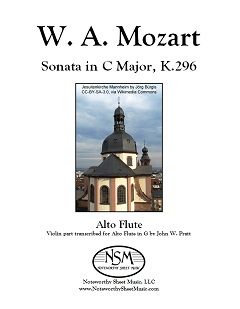 Sonata in C Major, K.296, by W. A. Mozart
Sonata in C Major, K.296, by W. A. MozartTranscribed for Alto Flute and Piano by John W. Pratt
Alto Flute Part, PDF $6.99
Mozart composed K.296 in 1778 under the same creative impulse as the other Mannheim violin sonatas, K.301‒306, but published it later, in 1781, with five other three-movement sonatas. He dedicated it to his Mannheim landlord's 15-year old daughter, Therese-Pierron Serrarius, who perhaps inspired the turns lightening the opening fanfares, quick trills in the first theme, and contrasting textures and sparkling interplay between the instruments in the first movement. The second movement is a beautiful arietta with wonderful opportunities for the alto flute to both present and accompany the melody. In the concluding Rondo, in sonata-rondo form, the instruments repeatedly swap the theme and much of the episodic material. ―J. W. Pratt
We provide our transcription of the violin part for alto flute; the piano score is available in the public domain as a free pdf download from imslp.org/.
For additional information about the seven Mozart Mannheim sonatas and their alto flute transcriptions, please read the Mozart’s Mannheim Sonatas article written by Mr. Pratt; the article was originally published by Flute Focus and subsequently republished by NSM on our Resources – Reviews and Articles page.
Alto Flute part, 7 pages; Total, 10 pages.
Preview -
Mozart - Sonata in C Major, K.303 - Alto Flute
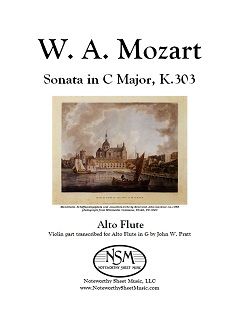 Sonata in C Major, K.303, by W. A. Mozart
Sonata in C Major, K.303, by W. A. MozartTranscribed for Alto Flute and Piano by John W. Pratt
Alto Flute Part, PDF $4.99
Both movements of Mozart's Sonata in C Major, K.303 are quite different from others of his 'Mannheim' set. The unusual first movement is in sonata form mixing retro and novel features—the whole first subject and transition to the dominant are adagio and considerably varied in the recapitulation, and there is no development. The second movement is an old-style minuet (without trio), ending with a pedal point terminating in a tremble. Our transcription for alto flute shifts the violin part to a different octave in three short segments and we have substituted musically appropriate alternatives for the double stops. We provide our transcription of the violin part for Alto Flute in G; the piano scoreis available in the public domain as a free pdf download from imslp.org/.
Alto Flute part, 5 pages; Total, 8 pages.
Preview -
Mozart - Sonata in D Major, K.306 - Alto Flute
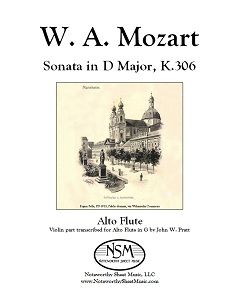 Sonata in D Major, K.306, by W. A. Mozart
Sonata in D Major, K.306, by W. A. MozartTranscribed for Alto Flute and Piano by John W. Pratt
Alto Flute Part, PDF $9.99
Mozart's Sonata in D Major, K.306 is by far the longest and showiest of the 'Mannheim' sonatas, with three large-scale movements, some quasi orchestral textures, much doubling, and brilliant passage work. The first movement's development expands four transitional bars of the exposition into a far-reaching harmonic excursion. The recapitulation begins with the second subject and returns to the first so late it amounts to a coda, the only instance of 'mirror' sonata-form in the Mannheim set. In contrast, the second movement, Andante cantabile, has a structurally orthodox sonata form, compressing and ornamenting the themes in the recapitulation, as befits the tempo. The finale is an elaborate rondo alternating between allegretto in 2/4 and allegro in 6/8. (excerpted from JWP's foreword to the edition)
We provide our transcribed alto flute part; the piano scoreis available in the public domain as a free pdf download from imslp.org/.
Alto Flute part, 10 pages; Total, 12 pages.
Preview -
Mozart - Sonata in E minor - Alto Flute
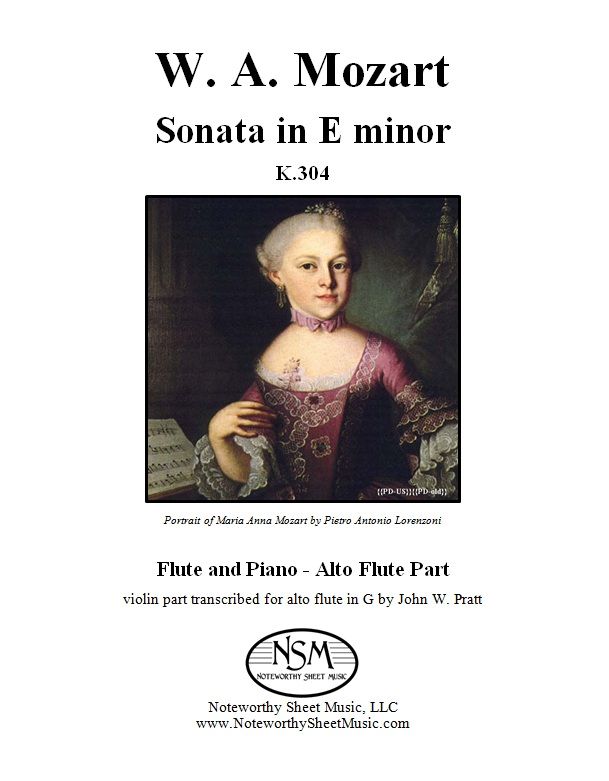 Sonata in E minor, K.304, by W. A. Mozart
Sonata in E minor, K.304, by W. A. MozartTranscribed for Alto Flute and Piano by John W. Pratt
Alto Flute Part, PDF $5.99
Mozart's second group of violin sonatas, the seven "Mannheim" sonatas of 1778, were begun in Mannheim where Mozart also worked on a flute commission. The violin parts rarely make significant use of double stops and are in general very well suited to alto flute. It is perhaps suggestive for performance that Mozart designated all his violin sonatas for "piano and violin".
Mozart's works in minor keys are rare and special: consider the G-minor quintet and Symphony No. 40. The K.304 sonata is his only work in E minor and it is mysteriously compelling in its simplicity. It was written the same summer that his mother died.
We provide the transcribed alto flute part; the piano score is readily available in the public domain, free of charge.
For additional information about the seven Mozart Mannheim sonatas and their alto flute transcriptions, please read the Mozart’s Mannheim Sonatas article written by Mr. Pratt; the article was originally published by Flute Focus and subsequently republished by NSM on our Resources – Reviews and Articles page.
Alto Flute part, 5 pages; Total, 8 pages.
Preview -
Mozart - Sonata in E-flat Major, K.302 - Alto Flute
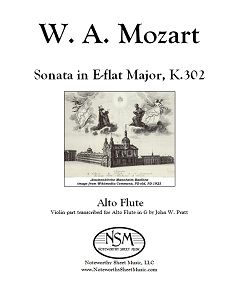 Sonata in E-flat Major, K.302, by W. A. Mozart
Sonata in E-flat Major, K.302, by W. A. MozartTranscribed for Alto Flute and Piano by John W. Pratt
Alto Flute Part, PDF $4.99
Mozart's Sonata in E-flat Major, K.302 has two movements, an Allegro and a rondo Andante grazioso. This ebullient sonata opens with a striking call to attention, much used later, which descends on the tonic triad but alternates half and quarter notes in 3/4 time, thus avoiding both square rhythm and repeated root positions on every down beat. The theme which follows is contrastingly gentle. The second movement offers a firmly forward-moving theme whose immediate repeat and final returns are variously and charmingly re-orchestrated. (excerpted from JWP's foreword to the edition)
We provide our transcription of the violin part for alto flute; the piano score is available in the public domain as a free pdf download from imslp.org/.
For additional information about the seven Mozart Mannheim sonatas and their alto flute transcriptions, please read the Mozart’s Mannheim Sonatas article written by Mr. Pratt; the article was originally published by Flute Focus and subsequently republished by NSM on our Resources – Reviews and Articles page.
Alto Flute part, 5 pages; Total, 8 pages.
Preview -
Mozart - Sonata in G Major - Alto Flute
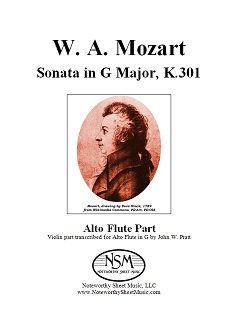 Sonata in G Major, K.301, by W. A. Mozart
Sonata in G Major, K.301, by W. A. MozartTranscribed for Alto Flute and Piano by John W. Pratt
Alto Flute Part, PDF $4.99
This sunny sonata has two movements, an up-beat Allegro con spirito followed by an Allegro that is actually a sprightly minuet with a trio section in the minor, almost as near to a Beethoven scherzo as a Haydn minuet. The violin leads as often as the piano, including at the beginning and throughout the trio, but is largely spared Mozart's typical keyboard passage work. As with six other violin sonatas composed in 1778, the first of Mozart's maturity, the violin part rarely makes significant use of double stops and is in general very well suited to alto flute. In fact, K.301 was begun with flute in mind. We provide our transcribed alto flute part. The piano score is available in the public domain as a free pdf download from imslp.org/.
For additional information about the seven Mozart Mannheim sonatas and their alto flute transcriptions, please read the Mozart’s Mannheim Sonatas article written by Mr. Pratt; the article was originally published by Flute Focus and subsequently republished by NSM on our Resources – Reviews and Articles page.
Alto Flute part, 4 pages; Total, 6 pages.
Preview -
Nielsen - Fantasy Pieces - Alto Flute & Piano
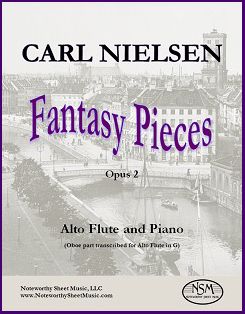 Fantasy Pieces, Op.2, by Carl Nielsen
Fantasy Pieces, Op.2, by Carl NielsenTranscribed for Alto Flute by C.A.Vater
Piano Score and Alto Flute Part, PDF $9.99
The Fantasy Pieces for Oboe and Piano, Op.2 (Fantasistykker for obo og klavier) were composed in 1889, when Nielsen was 24. They were written in the romantic idiom before his compositions became more experimental, chromatic, and dissonant. Nielsen wrote the Fantasy Pieces for his good friend Olivo Kraüse, the Danish oboist and composer to whom the work is dedicated. Nielsen and Krause were colleagues in the Royal Chapel Orchestra. The Fantasy Pieces were premiered by Krause and the pianist Victor Bendix at a Royal Orchestra Soirée in Copenhagen in 1891. Arrangements of the pieces for violin (with orchestra or piano), created by Hans Sitt, subsequently became quite popular.
Our transcription of the oboe part for alto flute is a simple transposition, as the entire oboe part falls nicely within the range of the alto flute. Although the tonal characteristics of the alto flute and oboe are very different, the Fantasistykker sound so natural on alto flute that the listener might think that the two pieces were composed specifically for that instrument.
The first piece, Romance, is a beautiful andante that allows the alto flutist to exploit the rich, sensuous sonority of the instrument. The contrasting second piece is a lively Humoresque in which the performer's lightheartedness and technical agility prevail.
Alto Flute part, 3 pages; Piano Score, 10 pages; Total, 18 pages.
Preview -
Pierné - Canzonetta - Alto Flute & Piano
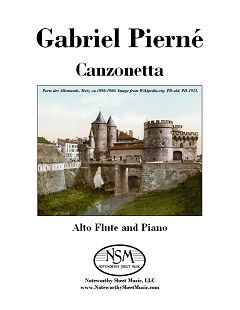 Canzonetta, Op.19, by G. Pierné
Canzonetta, Op.19, by G. PiernéTranscribed for Alto Flute and Piano by C.A.Vater
Piano Score and Alto Flute Part, PDF $6.99
Gabriel Pierné composed his Canzonetta for clarinet and piano (Op.19) in 1888, and it is among his most charming lighter works. The number of commercial recordings of the piece attest to its enduring popularity, extending into the modern era. Pierné dedicated this short, cheerful little song to his friend Charles Turban (1845-1905), the French clarinetist and professor of clarinet at the Paris Conservatory. The main melody is bouncy and gay, and brings merriment to players and audiences alike. Others have created transcriptions for alto sax and for flute. The piece is just as delightful when played on alto flute, and we now offer our new edition for alto flute and piano. Canzonetta would make a great encore piece for a concert or recital.
Alto Flute Part, 2 pages; Piano Score, 5 pages; Total, 10 pages.
Preview -
Pierné - Pièce - Alto Flute & Piano
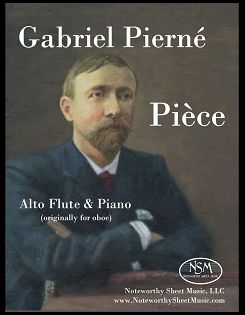 Pièce, Op.5, by Gabriel Pierné
Pièce, Op.5, by Gabriel Pierné Transcribed for Alto Flute and Piano by Carol A. Vater
Piano Score and Alto Flute Part, PDF $6.99
The Pièce en sol mineur for oboe (or violin or cello) with accompaniment of piano was composed by Gabriel Pierné in 1883. The alto flute is especially well-suited to this delightful, romantic piece, which falls completely and comfortably within the alto flute's range. Our edition includes both the alto flute part and the piano score.
Piano score, 5 pages; Alto Flute part, 2 pages; Total, 12 pages.
Preview -
Reger - Albumblatt - Alto Flute & Piano
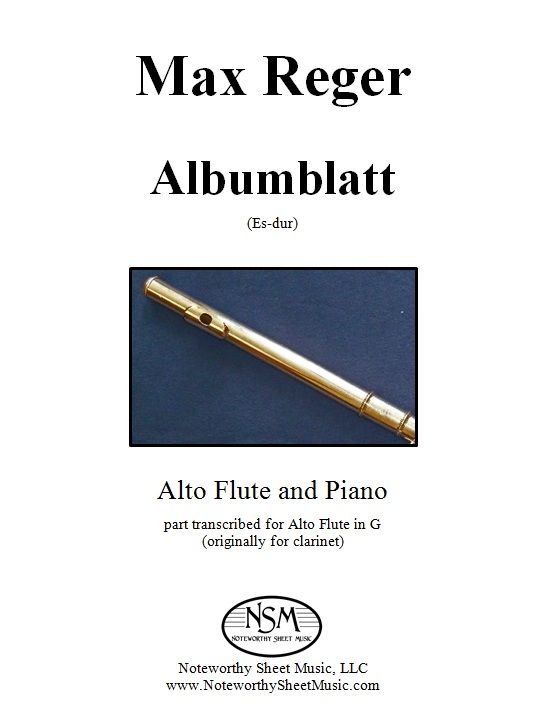 Albumblatt, by Max Reger
Albumblatt, by Max RegerTranscribed for Alto Flute and Piano by Carol A. Vater
Piano Score and Alto Flute Part, PDF $3.97
This gorgeous and surprisingly complex Albumblatt in E-flat major was written by Max Reger in ~1902 and originally scored for clarinet and piano. The piece is beautifully-suited to the range and sonority of the alto flute, and we provide here both our alto flute transcription of the clarinet part and a re-notated edition of the piano score.
Piano score, 2 pages; Alto Flute part, 1 page; Total, 5 pages.
-
Reger - Romanze - Alto Flute and Piano
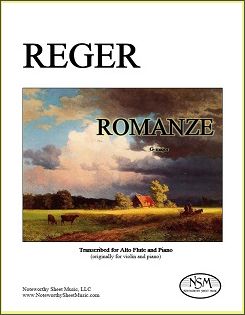 Romanze, by Max Reger
Romanze, by Max RegerTranscribed for Alto Flute in G and Piano by C.A.Vater
Alto Flute Part and Piano Score, PDF $4.99
Reger's Romanze is a lovely, short piece in G major, consisting of a single movement, Andante con moto. Written in 1902 for violin (or cello) and piano, the work was published by Breitkopf und Härtel ca.1920 and is now in the public domain. Numerous arrangements and transcriptions of the Romanze, including those for C-flute, trumpet, cello, clarinet, viola, or alto saxophone and piano, and even one for oboe and accordion, attest to the piece's popularity. The Romanze works beautifully on alto flute, and Noteworthy Sheet Music's 2016 edition includes both our transcribed alto flute part and a re-notated piano score.
Cover image courtesy of Wikimedia Commons, PD-old: "Bavarian Landscape", by Albert Bierstadt (1830–1902).
Alto Flute Part, 1 page; Score 2 pages; Total, 6 pages.
Preview -
Reger - Suite in A Minor - Alto Flute
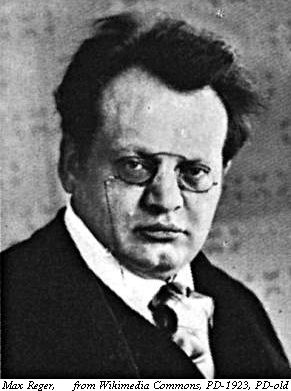 Suite in A Minor, Op.103a, by Max Reger
Suite in A Minor, Op.103a, by Max RegerTranscribed for Alto Flute and Piano by Carol A. Vater
Alto Flute Part, PDF $11.98
The Suite in A Minor for violin and piano by Max Reger was first published in 1908. The piece has been performed and recorded on flute, and arrangements of the beautiful Aria (3rd movement) have been published for violin and orchestra, as well as for cello and piano or organ. The piece is also highly suited to the rich, mellow sonorities of the alto flute. We offer here our transcription of all six movements of the violin part for alto flute. The piano part is readily available in the public domain as a free pdf download of the score for violin and piano. Here is a link to one such source: Piano Score
Alto Flute part, 12 pages; Total, 14 pages.
Preview -
Reinecke - Lieder - Voice, Violin (Fl/Afl), Piano
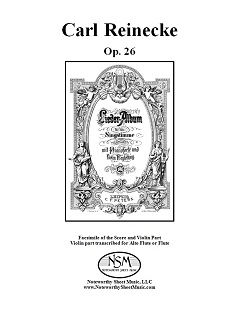 Waldesgruss and Frühlingsblumen, Op.26, by C. Reinecke
Waldesgruss and Frühlingsblumen, Op.26, by C. ReineckeFacsimile Edition plus Transcriptions for Flute & Alto Flute by C.A.Vater
Score for Violin, Voice, & Piano, Violin Part, Flute & Alto Flute Parts, PDF $9.98
Carl Reinecke (1824-1910) was a renowned German pianist, composer, conductor, and teacher of composition. He composed numerous works, and for over 35 years was a leader of the music scene in Leipzig. Reinecke's Op.26 includes two songs for voice with accompaniment of violin and piano: No.1, Waldesgruss (The Forest's Greeting); and No.2, Frühlingsblumen (Spring Flowers). The vocal range of Reinecke's Op.26 lieder extends from C4 to A5, and thus is well-suited for either soprano or mezzo-soprano.
Our edition contains an "enhanced" facsimile of the original score and violin part, plus new transcriptions of the violin part for either alto flute or flute. Thus, the two songs may be performed utilizing the accompaniment of violin, alto flute, or flute, along with the voice and piano. Alternatively, these pieces work very well as an instrumental arrangement with the voice part played on flute, accompanied by alto flute and piano.
Score, 6 pages; Violin, Alto Flute, and Flute parts, 2 pages each; Total, 18 pages.
Preview -
Saint-Saëns - Sonata - Alto Flute
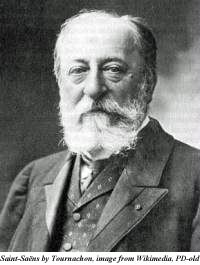 Sonata, Op.166, by Camille Saint-Saëns
Sonata, Op.166, by Camille Saint-SaënsTranscribed for Alto Flute and Piano by C.A.Vater and J.W.Pratt
Alto Flute Part, PDF $6.99
Sonata, Opus 166 (Oboe Sonata in D major) was composed by Saint-Saëns in 1921, the year of his death, and has since become a standard of the oboe repertoire. Although written for oboe with accompaniment of piano, the piece is very well suited for alto flute. Played by either oboe or alto flute, this Sonata provides the soloist with opportunities to demonstrate both technical expertise and expressive performance. We provide here the alto flute part; the piano part is readily available in the public domain as a free pdf download of the original score for oboe and piano. Here is a link to one such source: Piano Score
Alto Flute part, 7 pages; Total, 9 pages.
Preview -
Schubert - Der Hirt auf dem Felsen - Alto Flute (clarinet trans.)
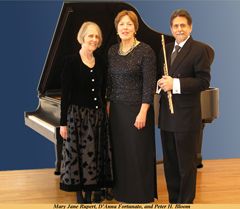 Der Hirt auf dem Felsen, Op.129, by F. Schubert
Der Hirt auf dem Felsen, Op.129, by F. Schubert Obbligato Transcribed for Alto Flute in G by Peter H. Bloom
Alto Flute Part, PDF $5.99
In the preface to his transcription, Mr. Bloom writes: "In terms of color, nuance, expression, dynamics, and tessitura the obbligato works exquisitely on the alto flute. Theobald Boehm (1794-1881) designed our first modern alto flute in 1847. Had Schubert (born in 1797) survived to hear it, I have no doubt that he would have made the alto flute an essential part of his armory of orchestration..... Der Hirt auf dem Felsen is very effective, also, in a purely instrumental arrangement for flute (taking the vocal line) and alto flute obbligato. It's an ideal didactical vehicle for coaching the developing flutist in the art of rhetorical performance as well as a splendid concert/recital piece."
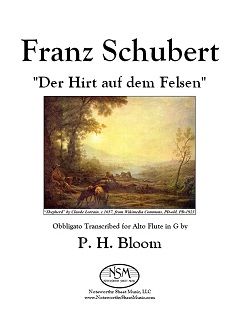
The premiere of Schubert's The Shepherd on the Rock, with obbligato transcribed for alto flute, was performed by D'Anna Fortunato (Mezzo-Soprano), Peter H. Bloom (Alto Flute), and Mary Jane Rupert (Piano) during a concert at the Gibson Theatre in Elmira, NY, on November 3, 2009, as part of the Elmira College Encore Series.
"Flutist Peter Bloom has done an invaluable service to Schubert and to concert singers by providing this charming arrangement, for alto flute, of the original clarinet obbligato to Der Hirt auf dem Felsen. I've performed it in this version on several occasions and find that the flute timbre is alluring. It's so easy to blend with and respond to the alto flute! I believe that, had it been possible, the composer, himself, would have truly enjoyed this arrangement at a Schubertiade performance of his own." - D'Anna Fortunato
We provide our alto flute transcription of the obbligato part, originally for clarinet. The voice and piano parts are readily available as a free pdf download of the score, from sources such as imslp.org/.
Alto Flute part, 4 pages of music; Total, 8 pages.
Preview -
Schubert - Sonatas, Op.137 - Alto Flute
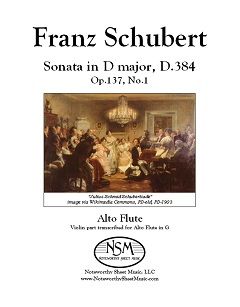 Sonatas, Op.137, by F. Schubert
Sonatas, Op.137, by F. SchubertTranscribed for Alto Flute and Piano by C. A. Vater & J. W. Pratt
No.1, Sonata in D major, D.384, Alto Flute Part, PDF $5.99
No.2, Sonata in A minor, D.385, Alto Flute Part, PDF $7.99
No.3, Sonata in G minor, D.408, Alto Flute Part, PDF $5.99
Franz Schubert (1797-1828) wrote his three violin sonatas Opus 137 when he was barely 19. They were published posthumously as 'Sonatinas', perhaps for marketing reasons, but they are full-scale sonatas in traditional classical style and format, the first having three movements and the others four. These plus the violin sonata in A of the next year constitute fully half of Schubert's known works for piano and solo instrument.
Schubert's Op.137 sonatas are truly delightful, and we have adapted the violin parts for alto flute. Where appropriate, changes have been introduced to better accommodate the range, sonority, and general characteristics of the alto flute. Such modifications include occasional octave adjustments, dynamic changes, and suitable flute-friendly alternatives to the violin's doublestops. We provide our transcribed alto flute parts; the piano scores are readily available in the public domain as free pdf downloads from imslp.org/.
No.1, Sonata in D major: Alto Flute part, 6 pages; Total, 8 pages. PDF $5.99
Preview
No.2, Sonata in A minor: Alto Flute part, 8 pages; Total, 10 pages. PDF $7.99
Preview
No.3, Sonata in G minor: Alto Flute part, 6 pages; Total, 8 pages. PDF $5.99
Preview -
Schubert – Der Hirt auf dem Felsen – Alto Flute (voice trans.)
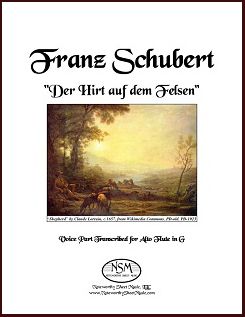 Der Hirt auf dem Felsen, Op.129, by F. Schubert
Der Hirt auf dem Felsen, Op.129, by F. Schubert Voice Part Transcribed for Alto Flute in G by Carol A. Vater
Alto Flute Part, PDF $5.99
NSM published Peter H. Bloom's alto flute transcription of the clarinet obbligato from Schubert's Shepherd on the Rock in 2012. Please find information about that publication in our article for that edition. Later we realized that the voice part, which I have performed on flute in a flute/clarinet/piano group, would work much better when played on alto flute. So we created a transcription of the vocal part for alto flute. This alto flute transcription is to be played in an entirely instrumental version of Der Hirt auf dem Felsen for alto flute, clarinet (or alto flute), and piano, which as noted by Mr. Bloom, is "an ideal didactical vehicle for coaching the developing flutist in the art of rhetorical performance as well as a splendid concert/recital piece." Our alto flute transcription of the voice part is a simple transposition requiring no octave changes; the part falls naturally and beautifully within the alto flute range. The clarinet part and piano score are freely available at IMSLP.org.
Preview -
Schubert – Erlking – Duo (Vo, Vc, Va, or Afl with Pf)
Erlkönig, by Franz Schubert
Arranged for Cello (or Viola or Alto Flute) and Piano by John W. Pratt
Piano Score and Parts for Cello/Voice, Viola, and Alto Flute; PDF $11.99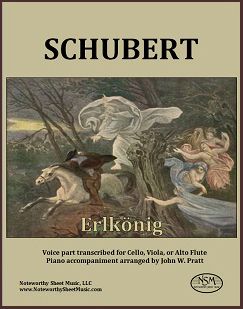 Franz Schubert (1797-1828), inspired by reading Goethe's poem, wrote his song "Erlkönig" in a few hours in 1815. The song was an immediate hit, and continues to be popular to the present day. John Pratt has created a trio arrangement for flute, cello, and piano (click for more information), and also the duo version offered here with Schubert's solo voice part transposed for cello (or viola or alto flute), and with a less arduous alternative to Schubert's piano accompaniment.
Franz Schubert (1797-1828), inspired by reading Goethe's poem, wrote his song "Erlkönig" in a few hours in 1815. The song was an immediate hit, and continues to be popular to the present day. John Pratt has created a trio arrangement for flute, cello, and piano (click for more information), and also the duo version offered here with Schubert's solo voice part transposed for cello (or viola or alto flute), and with a less arduous alternative to Schubert's piano accompaniment.Excerpted from Mr. Pratt's © preface:
"In the duo arrangement, Schubert's solo part is adopted without change. Thus the piano must provide the entire accompaniment, but rocking triplets and other pianistically felicitous passagework replace Schubert's unremitting repetition. The range of sonorities is also wider than Schubert's, though more restrained than that of the trio arrangement, where the flute enlarges the musical terrain. This accompaniment is offered as a less punishing alternative to Schubert's, to be played with a singer or any solo instrument. Solo parts are provided for voice or cello, viola, and alto flute."
Preview
Piano score, 6 pages; Cello, Viola, and Alto Flute parts, 2 pages each; Total, 22 pages.
We also offer a printed hard copy edition of Erlking for $20.38 plus a $5.95 shipping and handling fee to addresses in the USA. Please use the Contact Us form to let us know which hard copy publication(s) you would like to purchase, along with your email contact information and USPS mailing address. We will then send you a PayPal invoice for the sale and, once we receive notice from PayPal that you have paid for the item(s), we will ship your music to the address provided.
-
Schumann - Drei Romanzen - Alto Flute
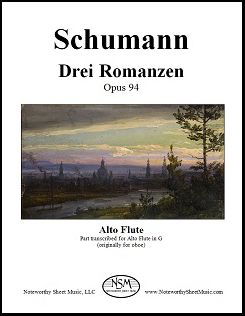 Drei Romanzen, Op.94, by Robert Schumann
Drei Romanzen, Op.94, by Robert SchumannTranscribed for Alto Flute (and Piano) by Carol A. Vater
Alto Flute Part, PDF $6.49
Robert Schumann composed his Drei Romanzen (Opus 94) for oboe and piano in 1849, and Simrock published the first edition, Drei Romanzen für Hoboe, ad libitum Violine oder Clarinette, mit Begleitung des Pianoforte, in 1851. Others have created arrangements of this popular piece for additional instruments, including cello, alto sax, soprano sax, tuba, flute, and horn. The 3 Romances are beautifully adaptable to the alto flute’s range and sonority. We provide here the alto flute part; the piano part is readily available in the public domain, free, as a pdf download of the score for oboe and piano. Here is a link to one such source: Piano Score.
Preview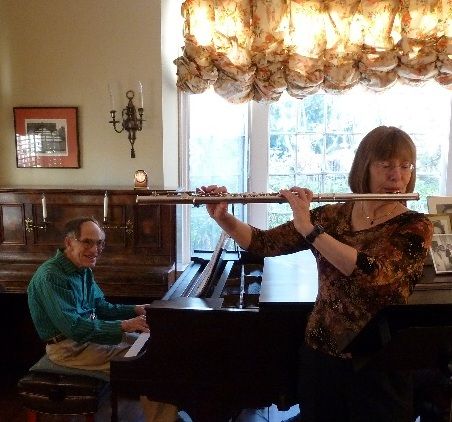 Alto Flute part, 6 pages; Total, 8 pages
Alto Flute part, 6 pages; Total, 8 pages